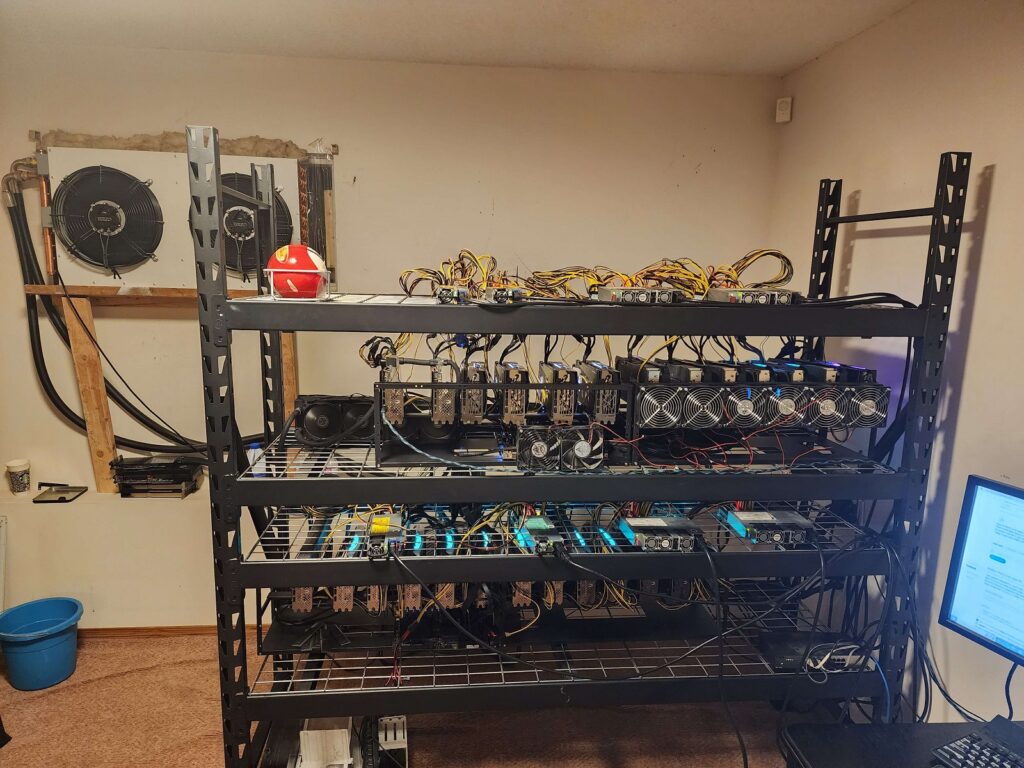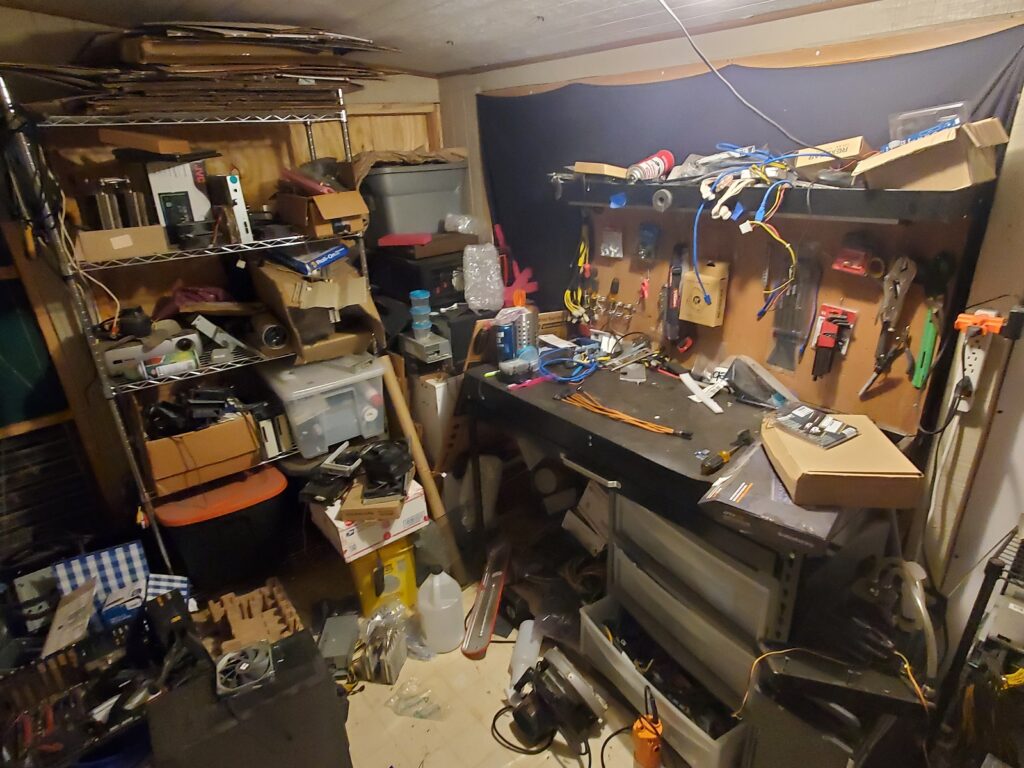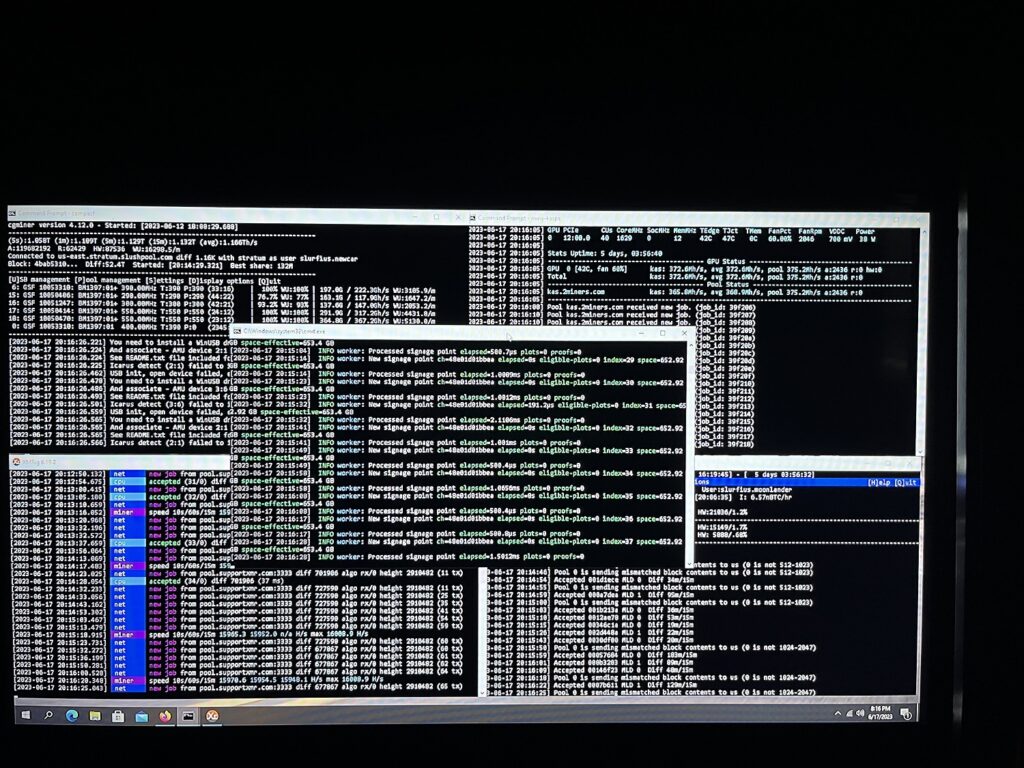The term “Ethereum Mining Rig” has been a buzzword for tech enthusiasts and crypto miners alike. While Ethereum has transitioned to Proof of Stake (POS), the allure and significance of mining rigs remain. This article delves deep into the intricacies of building an Ethereum mining rig, its historical context, and the potential of mining other cryptocurrencies.
Table of Contents
The Basics of Ethereum Mining
What is Ethereum mining?
Ethereum mining was once the process of solving complex mathematical problems to validate transactions on the Ethereum network. Miners used powerful hardware to compete and earn rewards in the form of Ethereum tokens.
How did Ethereum mining work before the transition to POS?
Before the shift to POS, Ethereum operated on a Proof of Work (PoW) mechanism. Miners would use their rigs, primarily GPUs, to solve cryptographic puzzles. The first to solve would add a new block to the blockchain and receive Ethereum as a reward.
Importance of mining hardware in the crypto ecosystem
Mining hardware, especially crypto mining rigs, played a pivotal role in maintaining the security and decentralization of the Ethereum network. Their computational power ensured faster transaction validations.
Why Build an Ethereum Mining Rig in 2024?

Historical significance and nostalgia
For many, building an Ethereum mining rig is a nod to the golden days of crypto mining, a tangible connection to the roots of blockchain technology.
Versatility of mining rigs for other cryptocurrencies
Even though Ethereum has moved to POS, these rigs are versatile. They can be repurposed to mine other profitable cryptocurrencies.
Educational purposes and understanding the mechanics
Building a rig offers hands-on experience, providing insights into the technical aspects of blockchain and crypto mining.
Components of an Ethereum Mining Rig
| Component | Description | Historical Best Picks |
|---|---|---|
| Graphics Units (GPUs) | Heart of the mining rig, responsible for solving puzzles | NVIDIA GTX 3060 Ti, AMD RX 580 |
| Mining Motherboard | Connects all components, supports multiple GPUs | ASUS B250 Mining Expert |
| Power Supply (PSU) | Powers the rig, efficiency is crucial | Corsair RMx Series |
| RAM & Storage | Supports the OS and mining software | 8GB DDR4, 120GB SSD |
| Cooling Solutions | Maintains optimal temperatures | Donnager case, Noctua fans, Liquid cooling |
| Mining Software | Interface to manage and monitor mining | Trex, Teamredminer |
Step-by-Step Guide: Building Your Ethereum Mining Rig
1. Preparing the Workspace

Safety First
Before starting, ensure you’re working in a well-lit, static-free environment. Using an anti-static wrist strap can prevent potential damage to your components.
Organize Your Tools
You’ll need screwdrivers, cable ties, and thermal paste. Lay out all your components and tools so they’re within easy reach.
Workspace
Choose a spacious table or workbench. This will give you ample space to lay out components and assemble the rig.
2. Assembling the Hardware Components
- Motherboard Setup:
- Place the motherboard on a non-conductive surface.
- Install the CPU, ensuring the pins align correctly. Lock it in place.
- Apply thermal paste to the CPU and attach the cooler.
- Insert RAM sticks into their slots, ensuring they click into place.
- Setting Up the GPUs:
- If using riser cables (common in multi-GPU setups), connect them to the motherboard.
- Attach the GPUs to the riser cables or directly to the motherboard if not using risers.
- Power Supply Connection:
- Connect the main power cable to the motherboard.
- Attach the CPU power cable.
- Connect power cables to each GPU.
- Ensure the storage device (SSD/HDD) is powered.
- Cooling Mechanism:
- Attach fans to the case or frame of your rig.
- Ensure airflow direction is consistent, usually from the front/bottom to the back/top.
- If using liquid cooling, set up the reservoir, pump, and ensure the loop is secure.
- Final Touches:
- Connect any additional peripherals like a monitor, keyboard, and mouse.
- Tidy up using cable ties to ensure good airflow and a clean setup.
3. Setting Up the Mining Software

- OS Installation:
- Install a preferred operating system. Linux and Windows are popular choices for mining.
- Ensure all drivers, especially GPU drivers, are updated.
- Mining Software:
- Download and install your chosen mining software. Options include Trex (Nvidia), Teamredminer (AMD), and Lolminer (Nvidia + AMD).
- Configure the software by selecting the cryptocurrency you’re mining, entering the address of your wallet, and choosing a mining pool if you’re not solo mining.
- Optimization:
- Adjust GPU clock speeds, power limits, and memory clocks for optimal performance and efficiency using tools like MSI Afterburner.
4. Testing and Troubleshooting
- Initial Boot:
- Power on the rig. Ensure all components, especially GPUs, are recognized and functioning.
- Benchmarking:
- Run a benchmark test to ensure your rig’s performance matches expectations.
- Temperature Monitoring:
- Keep an eye on component temperatures during the initial run. GPUs should remain below 65°C for most models.
- Troubleshooting:
- If the rig doesn’t power on, check all connections.
- If a GPU isn’t recognized, try swapping riser cables or PCIe slots.
- For software issues, consult forums or the software’s support community.
Building an Ethereum mining rig is a meticulous process, but with patience and attention to detail, you can assemble a powerful machine ready to tackle the challenges of cryptocurrency mining.
What to Mine After Ethereum’s Move to POS?
The transition of Ethereum to Proof of Stake (POS) has left miners with powerful rigs searching for the next profitable venture. Fortunately, the crypto landscape is vast, and there are several promising coins to mine. Here’s a breakdown:
Adapting your Ethereum mining rig for other cryptocurrencies
The transition of Ethereum to Proof of Stake (POS) has left many miners with rigs optimized for Ethereum’s Ethash algorithm. However, the versatility of these rigs means they can be repurposed for mining other cryptocurrencies. Here’s how:
1. Understanding the Algorithm:
Different cryptocurrencies use different consensus algorithms. While Ethereum used the Ethash algorithm, other coins might use algorithms like Kawpow, Octopus, or other GPU mineable POW algo. Before adapting your rig, understand the algorithm of the cryptocurrency you’re targeting.
2. Software Configuration:
- Mining Software: Ethereum miners might be familiar with software like Trex or Teamredminer. When switching to a different cryptocurrency, you might need to use different software or update settings. For instance, mining Nexa would require software like Lolminer or Bzminer.
- Wallet Setup: Ensure you have a secure wallet for the new cryptocurrency. This wallet address will be needed to configure your mining software.
- Pool Selection: If you’re not solo mining, you’ll need to join a mining pool for the chosen cryptocurrency. Update your mining software with the pool’s address.
3. Hardware Considerations:
- GPU Settings: The overclocking (OC) settings optimized for Ethereum might not be ideal for other cryptocurrencies. Adjust the core and memory clocks, power limits, and fan speeds to optimize for the new coin. Tools like MSI Afterburner can assist in this.
- ASIC Resistance: Some cryptocurrencies, like Ravencoin or Conflux, are designed to be ASIC-resistant, favoring GPU miners. This is good news for those with Ethereum mining rigs, as they can potentially mine these coins profitably.
- Cooling and Power: Different algorithms might exert varying levels of stress on your GPUs. Monitor temperatures and power consumption, adjusting cooling solutions as necessary.
4. Testing and Benchmarking:
Once you’ve reconfigured your rig, it’s essential to test its performance. Run benchmarks to ensure your GPUs are performing optimally for the new cryptocurrency. Monitor for any stability issues or excessive heat generation.
5. Stay Updated:
The world of cryptocurrency is dynamic. New coins emerge, algorithms get updated, and market values fluctuate. Regularly check crypto forums, news sites, and communities to stay informed about the best mining opportunities.
6. Dual or Triple Mining:
Some miners opt to mine multiple cryptocurrencies simultaneously. If your rig has sufficient power and cooling, you can configure it to mine two or even three different coins at once. However, this requires careful management of software and settings to ensure profitability.
Single Coin Mining:
- ETHW: A coin with the same algorithm as Ethereum, it allows miners to use the same Overclock (OC) settings. This makes the transition from Ethereum to ETHW seamless.
- ETC (Ethereum Classic): Another coin with the Ethereum algorithm. ETC has been a consistent choice for miners and offers stability in the market.
- RVN (Ravencoin): Known for its Kawpow algorithm, RVN adjusts itself to prevent ASIC dominance, favoring GPU miners.
- CFX (Conflux): Uses the Octopus algorithm and offers a unique approach to scalability and security in blockchain.
- ERG (Ergo): Operates on the Autolykos algorithm, designed for decentralized mining by both pools and solo miners.
Dual Mining:
Dual mining allows miners to mine two coins simultaneously, maximizing the potential profit.
- ETHW+ALPH: Combining the stability of ETHW with the potential of ALPH can yield good returns.
- ETHW+RXD: Another combination that utilizes the Ethereum algorithm for ETHW and the unique attributes of RXD.
- ETC+ALPH: Ethereum Classic’s stability paired with ALPH can be a lucrative venture.
Triple Mining:
For those looking to maximize their mining rig’s potential, triple mining can be an option. It involves mining three coins, usually with one being a smaller, less resource-intensive coin.
- ETHW+ALPH+ZIL: While ETHW and ALPH are the primary coins, ZIL (Zilliqa) acts as a supplementary coin, adding to the overall profitability.
- ETC+RXD+ZIL: Combining the stability of ETC, the potential of RXD, and the supplementary benefits of ZIL.
Tips for Efficient and Profitable Mining
Mining can be both an exciting venture and a profitable one, but it requires a strategic approach to maximize efficiency and returns. Here’s a detailed elaboration on tips for efficient and profitable mining:
1. Energy Efficiency:
- Optimal Power Supply: Invest in a high-quality Power Supply Unit (PSU) with an 80 PLUS Gold or Platinum rating. These units operate at higher efficiencies, reducing wasted power.
- Underclocking and Undervolting: Reduce the power consumption of your GPUs by underclocking them. This can also lead to lower temperatures, extending the lifespan of your hardware.
- Energy Costs: Be aware of your local electricity rates. Mining during off-peak hours or in regions with lower electricity costs can significantly boost profitability.
2. Hardware Optimization:
- Regular Maintenance: Dust and debris can reduce the cooling efficiency of your rig. Regularly clean your hardware and ensure fans and heatsinks are free from obstructions.
- Cooling Solutions: Efficient cooling can prolong the life of your components. Invest in quality fans, consider liquid cooling systems, and ensure your mining setup is in a well-ventilated area.
- Hardware Monitoring: Use software tools like HWiNFO or MSI Afterburner to keep an eye on temperatures, power consumption, and other vital stats. This can help you spot issues before they become major problems.
3. Mining Strategy:
- Pool vs. Solo Mining: While solo mining can offer larger rewards, they are infrequent. Mining pools provide smaller, more consistent payouts. Evaluate the pros and cons of each based on your risk tolerance and mining capacity.
- Switching Cryptocurrencies: Stay updated with market trends. Sometimes, switching to a different cryptocurrency can be more profitable due to price surges or algorithm changes.
- Use Mining Calculators: Tools like WhatToMine or WoolyPooly calc can help you determine the most profitable coin to mine based on your hardware and electricity costs.
4. Security Measures:
- Secure Your Wallet: Use hardware wallets or encrypted digital wallets to store your earnings. Regularly backup your wallet and use strong, unique passwords.
- Enable 2FA: Two-Factor Authentication adds an extra layer of security to your mining accounts and wallets.
- Stay Updated: Ensure your mining software, wallets, and system OS are regularly updated. This protects you from vulnerabilities and potential hacking attempts.
5. Stay Informed:
- Join Mining Communities: Platforms like Bitcointalk or Reddit have vast communities of miners. Engaging in these can provide insights, tips, and updates from experienced miners.
- Educate Yourself: The world of cryptocurrency is vast and ever-evolving. Regularly read articles, watch tutorials, and attend webinars or workshops to enhance your mining knowledge.
- Regulatory Awareness: Stay informed about local regulations related to cryptocurrency and mining. This ensures you’re compliant and avoids potential legal complications.
Conclusion
In the intricate dance of numbers, algorithms, and digital currencies, mining stands out as both a technological marvel and a testament to the decentralized vision of cryptocurrencies. It’s not just about setting up rigs and reaping rewards; it’s a continuous journey of optimization, adaptation, and learning.
The Evolution of Mining: From the early days of Bitcoin mining on simple CPUs to today’s sophisticated Ethereum rigs and beyond, mining has undergone a transformative journey. It’s no longer the realm of the tech-savvy few but an industry that beckons enthusiasts, investors, and innovators alike.
The Balance of Tech and Strategy: Efficient mining isn’t solely about having the best hardware. It intertwines the raw power of GPUs and ASICs with the finesse of strategic decisions—choosing the right coin, joining a pool versus solo mining, and constantly adjusting to market dynamics.
Sustainability and Profitability: As the environmental impact of mining becomes a focal discussion point, the emphasis on energy-efficient setups has never been more critical. Miners are now tasked with not just maximizing profits but doing so responsibly. This balance is crucial for the long-term viability of mining as both a hobby and an industry.
The Power of Community: Mining, in its essence, is a communal activity. Whether it’s through pools, forums, or global conferences, the collective knowledge and camaraderie of the mining community play a pivotal role in navigating its challenges. Sharing insights, troubleshooting issues, and celebrating successes together underscores the collaborative spirit of the crypto world.
Looking Ahead: The future of mining is as unpredictable as the crypto market itself. With advancements in quantum computing, potential shifts to more Proof of Stake (PoS) algorithms, and ever-evolving regulatory landscapes, miners must stay agile. But with challenges come opportunities—for innovation, growth, and forging the future of decentralized finance.
In essence, mining is more than just a pursuit of digital gold. It’s a commitment to understanding the pulse of the crypto world, adapting to its rhythms, and continuously striving for excellence. As the digital frontier expands, those willing to learn, innovate, and persevere will find mining a rewarding journey, both intellectually and financially.
FAQs
Can I use my Ethereum mining rig for other purposes?
Absolutely! Your rig can be repurposed for gaming, graphic design, or mining other cryptocurrencies.
Why is Ethereum no longer mineable?
Ethereum transitioned to a Proof of Stake (POS) mechanism, eliminating the need for energy-intensive mining.
Is crypto mining still profitable in 2024?
Yes, while Ethereum is off the table, several other cryptocurrencies offer lucrative mining opportunities.